![]()
L'Arrouye: a great colour for a little number of Great Pyrenees
![]()
![]()
I wish to introduce some information I collected for better knowing the unusual colour "rust" called "arrouye".
This peculiarity can be found only in a little number of Pyrenean Mountain Dogs.
In fact, in Italy and also abroad nowadays very few dogs preserve this rare and ancient characteristic.
How many time the "arrouye" can be confused with some other colours or misinterpreted!
The arrouye markings show a very bright, shining, warm and strong depth of tone "rust".
When I examined a young and also an adult dog with this colour, I noticed that the depth of the arrouye
was always more concentrated on the ears then on the markings of the head and of the body.
In adult dogs the markings don't disappear: they remain well marked.
In breeding, if a dog mated shows this particular characteristic,
usually it can be inherited by very few descendants (and unfortunately not always..).
In fact, on four litters composed by eight puppies each, I noticed that
only 2 descendants in the 1° litter, 3 descendants in the 2° litter, no puppies arrouye in the 3° litter
and 3 babies in the 4° litter showed this colour.
Another curiosity: at the birth these few puppies arrouye own a very dark brown markings and
only during the following months of growth the "shining arrouye" markings show up well.
At the birth some puppies arrouye have already a complete pigmentation on the nose and
when they are adult most of their nails are totally black coloured.

Anyway this rare colour is not a novelty because it has old origins.
Following my researches, in 1850 this colour was well described.
The Great Pyrenees "Cabas" owned by Queen Victoria had his markings of a colour "brown-reddish" .

During the first years of 1900, M. Dretzen which studied this breed, searched in the pyrenees mountains
still some "pure" specimens because they became so rare.
M. Dretzen examined 350 specimens and he discovered that only 6 of them (following his theory)
owned the right characteristics for being considered "typical dogs" and of "pure" breed.

Those 6 dogs lived at Bois-Colombes, near Paris where M. Dretzen founded his Kennel called "Zailea".
Among the dogs bred by M. Dretzen there were some few specimens with some "dark orange" markings
on the ears and on the root of the tail.
If we examine the Graduation Thesis written in 1943 by Doctor Fourcassié,
we can read that in the pyrenees mountains there were present some descendants by a Saint Bernard dog
(imported in those mountains during the end of the 1800) and maybe they "mixed" the breed of the Great Pyrenees.
So, could we think that the arrouye colour has been inherited by those few specimens?
I doubt for the big extent of that mountainous chain and for the good program of selection made later
by
the big dog-lovers and by the experts of the breed.

In a book written by M. J. Coly, we find the quotation of this colour.
In fact, the coat of the Great Pyrenees uniformly white or "white-reddish" is well described,
even if usually the dogs with the dark markings on the head, on the back and on the root of the tail like better....
Moreover M. J. Coly defines the existence of some specimens with "reddish" markings on the head
and on the back in the Vallée de l'Ouzon.
In another book of the same author, he talks about the colour arrouye
when he describes the natural markings of the Great Pyrenees and the writer tells that
"it is the marking/spot that makes the dog nice".
In more, the writer tells that people living in the mountains appreciate well the Great Pyrenees
with an ivory coat with shades of "reddish" and this dog dresses very well with these markings...
He also says that the colour in the Great Pyrenees could be the simple atavic maintenance
of
his far ancestor, that is the Molossian of Asia.

The colour arrouye is well shown on the coat of our Hamlet du Pic the Marboré - "Navarre"
and on the coat of numerous of his offspring.
Navarre's place of origin was in the heart of the Pyrenees mountains, near the Col du Tourmalet.
He was a descendant from the original Great Pyrenees Mountain stock and he lived happily 14 years with my family.
Navarre was a dog of "old type", very "rustic" and he represented well the Standard of the breed.
His structure and his "important" head reminded the Great Pyrenees shown in the old postcards of the first years of the 1900.
Navarre was endowed with intelligence and he kept many ancient qualities.
Thanks to his help, we are searching to "maintain" in his descendants all these old and rare qualities .
Elena Vespa

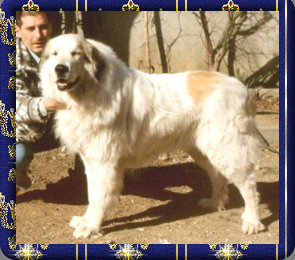
Hamlet du Pic de Marboré "Navarre"

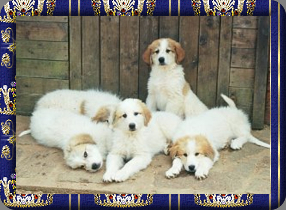
Noisette and some puppies born at du Royaume d'Ursita with "arrouye" markings

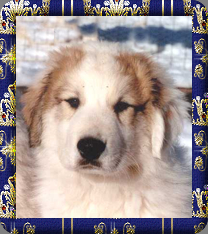
Vamour and Tango du Royaume d'Ursita
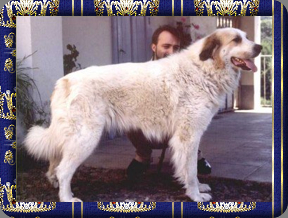
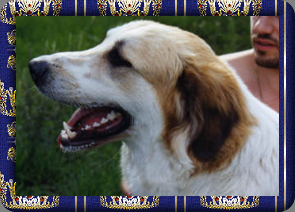
Navahermosa and Urguet du Royaume d'Ursita
![]()